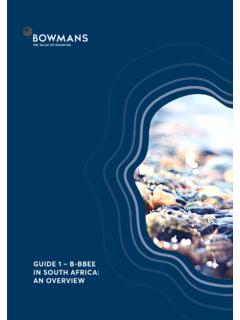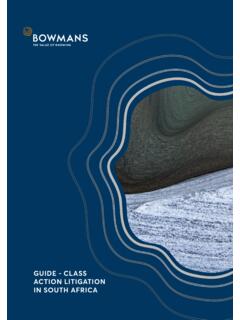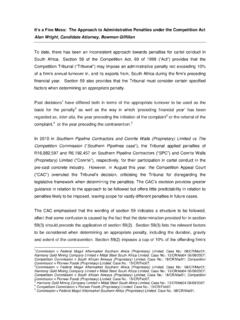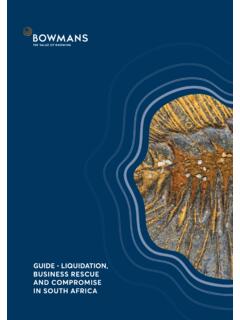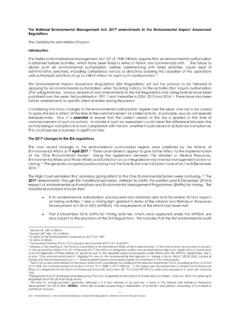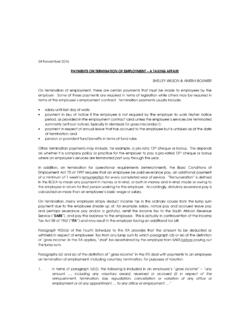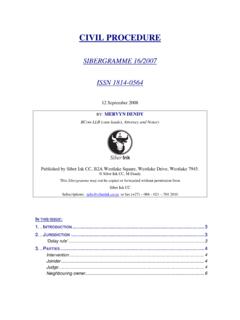Transcription of Penalties for Anti-Competitive Conduct: Sharpening the ...
1 Penalties for Anti-Competitive conduct : Sharpening the sting of south Africa s competition authorities (Note: This article was originally published by Siber Ink Publishers as part of the Sibergramme series ) Michael Wilter (Associate) at Bowman Gilfillan in Cape Town I. Introduction The recent series of administrative Penalties imposed on respondent firms by the south african competition authorities is indicative of an active competition law regime committed to the development of sustainable and pro- competitive south african business practices. However, it remains to be seen whether these measures in fact effectively address the Anti-Competitive conduct at which they are specifically directed and serve as a meaningful deterrent to potential offenders.
2 The south african Competition Act ( the Act )1 seeks to promote and maintain competition 2 in south Africa so that, in turn: (i) the efficiency, adaptability and development of the south african economy is promoted;3 (ii) consumers are provided with competitive prices and product choices ;4 (iii) employment is promoted and the social and economic welfare of south Africans is advanced;5 (iv) opportunities for south african participation in world markets are expanded and the role of foreign competition is recognised;6 and (v) small and medium-sized enterprises have an equitable opportunity to participate in the economy .7 It follows then that any Anti-Competitive conduct on the part of a firm which threatens or undermines the realisation of these objectives may warrant the imposition of an administrative penalty in terms of the Act.
3 1 Act No. 89 of 1998 (as amended). 2 Section 2 of the Act. 3 Section 2(a) of the Act. 4 Section 2(b) of the Act. 5 Section 2(c) of the Act. 6 Section 2(d) of the Act. 7 Section 2(e) of the Act. 1An administrative penalty is a punitive measure that the south african Competition Tribunal (the Tribunal ) may impose on a respondent firm in terms of the Act for participating in an Anti-Competitive practice prohibited by the Act; contravening the terms of an order made by the Tribunal or the Competition Appeal Court; or, albeit to a lesser extent, acting in contravention of the merger control provisions of the Such a penalty may be determined and enforced in one of two ways, namely: (i) determined and enforced unilaterally by the Tribunal in terms of section 59 of the Act.
4 Or (ii) determined in a consent agreement concluded between the respondent firm concerned and the south african Competition Commission (the Commission ) and approved and enforced by the Tribunal in terms of section 58 of the Act. A significant element of the determination of an effective administrative penalty is the turnover threshold that is provided for under section 59 of the Act, which caps the quantum of an administrative penalty at 10 per cent of the firm s annual turnover in the Republic and its exports from the Republic during the firm s preceding financial year .9 Despite the significance of this threshold to the determination of an appropriate administrative penalty, both the south african legislature and the south african competition authorities have shown a reluctance to define or consider the meaning of the term preceding financial year.
5 Furthermore, the Act does not regulate or provide guidance to the Tribunal in its determination of whether a consent agreement provides for an appropriate penalty for Anti-Competitive conduct in any given case (as is required of it in terms of section 58 of the Act). As such, the majority of consent agreements approved by the Tribunal to date have not necessarily been scrutinised in a manner which is consistent with and which promotes the objects of the Act. On the one hand, the absence of a definition for the term preceding financial year in section 59 of the Act and the absence of any regulations or directives which set out how a consent agreement is to be scrutinised under section 58 of the Act may be considered to provide the Tribunal with the flexibility needed to determine an appropriate administrative penalty in any given case.
6 On the other hand, a lack of a definition for the term preceding financial year in the Act has exposed the arbitrariness of this term and a lack of consistency in the Tribunal s decisions. A lack of clarity as to what constitutes an appropriate penalty in the context of a consent agreement approved under section 58 of the Act has further contributed to a lack of consistency in the Tribunal s decisions. 8 Section 59(1) of the Act. See Brassey et al Competition Law (Juta Law, Lansdowne: 2002) at 324-325. 9 Section 59(2) of the Act. 2 Collectively, these shortcomings of the Act have the potential to prevent respondent firms from appreciating in advance the extent to which they may be liable should they be found guilty of Anti-Competitive conduct by the Tribunal. In turn, this consequence may: (i) reduce the degree of deterrence which an administrative penalty may otherwise yield; and (ii) discourage foreign investors from investing and doing business in south Africa to the extent that they do not consider themselves protected by an effective competition law regime.
7 This result would surely frustrate the realisation of the objects of the Act. The south african model of determining administrative Penalties therefore needs to be refined to ensure that it is one which will facilitate the development and enforcement of punitive measures which are appropriate and effective in addressing Anti-Competitive conduct in south african markets and which ultimately will provide for the promotion and maintenance of competition in south Africa. II. What constitutes an appropriate administrative penalty? Unlike the compensatory nature of civil damages or the restorative nature of interdicts and positive obligations that may be imposed following a contravention of the Act, administrative Penalties are primarily aimed at penalising a respondent firm in a manner that will effectively deter that firm from committing further contraventions of the Act without threatening the financial sustainability of that Administrative Penalties also seek to deter potential offenders from participating in Anti-Competitive business practices prohibited by the The most optimal of fines has been described by commentators as one that fulfils the aim of The efficacy or appropriateness of an administrative penalty should therefore be measured with reference to the degree of deterrence that that penalty will ultimately This 10 Brassey et al (n 8) at 317.
8 11 Joshua The European Commission s New Fining Guidelines and How They May Affect Cartel Enforcement George Mason Law Review (13 September 2006) at 5 and 7. 12 Wehmh rner Optimal Fining Policies Paper presented at the Remedies and Sanctions in Competition Policy Conference, Amsterdam Centre for Law and Economics, February 2005 at 8. 13 Joshua (n 11) at 5 and 7. See also The Competition Commission of south Africa v Federal Mogul Aftermarket Southern Africa (Pty) Ltd and others Case Number: 08/CR/Mar01 ( the Federal Mogul case ) at para 166. 3notion has been accepted by the Deterrence is best achieved by setting the quantum of a fine as high as possible, provided that: (i) the fine does not exceed a firm s ability to pay; (ii) the burden of the fine is proportional to the actual harm caused to society; and (iii) the gravity of the fine does not discourage firms from engaging in conduct which would otherwise represent an efficiency Furthermore, the degree of deterrence that an administrative penalty yields will presumably be higher where the criteria against which the penalty is assessed and ultimately formulated is clear and known to all, particularly potential offenders who will thereby be better placed to anticipate and appreciate the likely consequences of any Anti-Competitive conduct .
9 Most fine setting models around the world, including the south african model,16 tend to provide for the calculation of a base fine, which serves as an indicator of what should be considered the maximum possible penalty in each case. Once calculated, this base fine is adjusted to appropriately reflect any mitigating and aggravating circumstances that may exist in each case. Where an inappropriately low fine is imposed on a respondent firm, a low degree of deterrence is likely to be achieved, as the respondent firm may very well consider a low fine to be a reasonable fee to continue engaging in Anti-Competitive conduct , merely a cost factored into the costs of conducting business. Conversely, where a high fine is levied on a respondent firm, a high degree of deterrence is likely to be achieved, provided that the social and economic well-being of that firm and all interested and affected stakeholders is not undermined.
10 This proviso is critical to the determination of an appropriate administrative penalty since a respondent firm may become insolvent where the penalty imposed exceeds the ability of that firm to pay. The insolvency of the respondent firm may give rise to adverse social and economic costs for all stakeholders concerned (including managers, shareholders, employees, suppliers, customers, creditors and tax authorities).17 Some of these social and economic costs include: (i) the depreciation of the value of securities held by creditors; (ii) the reduction of employee benefits and the retrenchment of staff as part of efforts to pay the penalty through cost-cutting measures; (iii) the reduction of tax receipts; and 14 The Federal Mogul case (n 13) at para 166.
